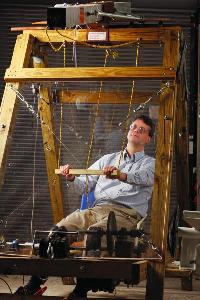Nov 7 2013
Worcester, Mass. – As the world looks for new ways to wean itself from fossil fuels, a new answer may be emerging: underwater kites.
 This is David Olinger, associate professor of mechanical engineering at Worcester Polytechnic Institute, with a rig that uses a rocking arm to translate the motion of wind-powered kite into rotary motion to spin an electric generator or power a device like a water pump. With an award from the National Science Foundation, Olinger is currently exploring the use of underwater kites to generate power from currents and tidal flows. (credit: Worcester Polytechnic Institute)
This is David Olinger, associate professor of mechanical engineering at Worcester Polytechnic Institute, with a rig that uses a rocking arm to translate the motion of wind-powered kite into rotary motion to spin an electric generator or power a device like a water pump. With an award from the National Science Foundation, Olinger is currently exploring the use of underwater kites to generate power from currents and tidal flows. (credit: Worcester Polytechnic Institute)
A new research program directed by David Olinger, PhD, associate professor of mechanical engineering at Worcester Polytechnic Institute (WPI), has received a three-year, $300,000 grant from the National Science Foundation (NSF) to explore ways to harness ocean currents and tidal flows using this unexpected technology. The work is scheduled to begin in January.
"Unseen under the waves, winding along coastlines and streaming through underwater channels, there are countless ocean currents and tidal flows that bristle with kinetic energy," Olinger said. "And just as wind turbines can convert moving air into electricity, there is the potential to transform these virtually untapped liquid 'breezes' into vast amounts of power. For example, it has been estimated that the potential power from the Florida Current, which flows from the Gulf of Mexico into the Atlantic Ocean, is 20 gigawatts—equivalent to about 10 nuclear power plants."
Olinger's new research builds on earlier work, funded by the NSF and the U.S. Environmental Protection Agency, in which he developed low-cost kite systems that use the wind to generate electricity or power simple devices like water pumps. With the NSF funds, Olinger and a team of graduate students developed computational models that can predict trajectories and power output for kites of different sizes and kite tethers of different lengths. The models can be used to design kites that can fly in stable, high-speed figure-eight patterns under changing wind conditions.
Through the new NSF award, those algorithms will be applied to the design of kites that can "fly" in underwater currents. "Instead of moving air, you have moving water and the kites have rigid wings," Olinger said, "but the same physical principles apply."
Using computational models, Olinger and his team will evaluate possible designs for undersea kites and explore methods for tethering them to floating platforms similar to those used for oil and gas rigs. They will also explore whether it is better, from the standpoints of power generation, environmental impact, and reliability, to mount turbine-generators directly to the kites or to place the generators on the platforms, connected to the kites by tethers that spin the generators as they spool and unspool on reels.
In the final stage of the research, they will build scale models of the kites and test them in a water tank at WPI and at the Alden Research Laboratory, a renowned hydraulics research facility where the kites will be "flown" in large water flumes.
Whichever design and generator configuration proves best, Olinger says he expects underwater kites to have important advantages over stationary marine turbines, which have been used on a limited scale in Europe, Asia, and North America to generate power from tides.
"For one, the generators can be smaller, since with the figure-eight motion the kite will move three- to five times faster than the current, greatly amplifying the power output— which could be as much as 64 times greater than the output of a comparably sized stationary turbine," he said. "And, since the kites will be attached to floating platforms, rather than located on the sea floor, they will be substantially less expensive to install and easier to retrieve for maintenance."